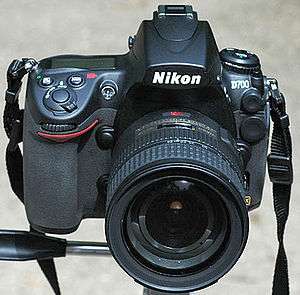Nikon D700
 | |
| Overview | |
|---|---|
| Type | Single-lens reflex |
| Lens | |
| Lens | Interchangeable, Nikon F mount |
| Sensor/Medium | |
| Sensor | 36 mm × 23.9 mm CMOS |
| Maximum resolution | 4,256 × 2,832 (12.1 million) |
| ASA/ISO range | 200–6400, extended mode to 100–12800, HI2 mode 25600 |
| Storage | CompactFlash (Type I only) |
| Focusing | |
| Focus modes | Single-servo (AF-S); Continuous-servo (AF-C); Manual (M) |
| Focus areas | 51 AF points (15 cross-type) |
| Exposure/Metering | |
| Exposure metering | TTL 3D Color Matrix Metering II with a 1005 pixel RGB sensor |
| Metering modes | Matrix metering, center-weighted metering, spot metering |
| Flash | |
| Flash | Manual pop-up with button release Guide number 12/39 (ISO 100, m/ft) |
| Flash bracketing | -3 to +1 EV in increments of 1/3 or 1/2 EV |
| Shutter | |
| Shutter | Electronically controlled focal-plane |
| Shutter speed range | 1/8000 to 30 sec, bulb, X-sync at 1/250 sec. |
| Continuous shooting | Approx. 5.0 frame/s, 8.0 frame/s w/battery grip |
| Viewfinder | |
| Viewfinder | Optical pentaprism, 95% coverage |
| General | |
| Rear LCD monitor | 3.0-inch (76 mm), VGA resolution, 307,200 pixels (921,600 dots) |
| Battery | Nikon EN-EL3e rechargeable Lithium-Ion battery |
| Weight | 995 g (35.1 oz), body only |
| Made in | Japan |
The Nikon D700 is a professional-grade full-frame digital single-lens reflex camera introduced by the Nikon Corporation in July 2008 and manufactured in Japan. It uses the same 12.1-megapixel "FX" CMOS image sensor as the Nikon D3, and is Nikon's second full-frame digital SLR camera.
The D700's full-frame sensor allows the use of non-DX F-mount lenses to their fullest advantage, with no crop factor. When a DX lens is mounted on the D700, either the DX-sized portion, or the (vignetted) FX-sized portion of the camera's sensor can be used. The D700 has a built in autofocus motor for all Nikon autofocus-lenses, includes CPU and metering for older Nikon F-mount AI/AI-S lenses,[1] and supports PC-E lenses.[2] The D700 bears a physical similarity to the Nikon D300, which uses the same MB-D10 battery pack and EN-EL3e battery. As of 2012, the Nikon D3X, the D3/D3s, D4 and D700 are the only Nikon DSLR models that are manufactured in Japan. It was discontinued on August 24, 2012.[3]
Features
- Nikon's 12.1 megapixel FX-format (23.9 mm × 36 mm) CMOS sensor
- Nikon EXPEED image processor
- Two Live View shooting mode (hand-held and tripod modes)
- Continuous Drive up to 5 frames per second (8 frames per second with the optional MB-D10 Multi-power Battery Pack)
- Nikon's Scene Recognition System, utilizing the 1,005-pixel RGB sensor
- 3D Color Matrix Metering II
- Approx. 95% Viewfinder Frame Coverage, 0.72× Viewfinder Magnification
- Multi-CAM 3500FX autofocus sensor module featuring 51 AF points with 3D Focus Tracking
- Electronic rangefinder function compatible with manual focus AI/AIs lenses using any of the 51 AF points
- Active D-Lighting (3 levels (Low; Normal; High) or Auto)
- Automatic correction of lateral chromatic aberration for JPEGs; correction data is additionally stored in RAW-files and can be used by Nikon Capture NX, View NX and some other RAW tools
- Vignetting ("Vignette control") correction, as well as image rotation ("Straighten") via playback ("Retouch") menu
- 3-inch (76 mm) LCD with 921,600-dot (VGA) resolution and a 170° ultra-wide viewing angle
- ISO sensitivity 200–6400 (100–25600 with boost)
- Auto-ISO function which can be capped with a maximum shutter time and maximum ISO value
- Magnesium alloy weather sealed body for dust and moisture protection
- Nikon F-mount lenses
- 9 Lens presets per user profile to improve program functions for non-CPU lenses and to include Exif information
- Aperture sensing ring on the body for readout of AI/AIs manual focus lens aperture settings
- Built-in Sensor cleaning system
- Built-in flash with 24 mm lens coverage and Nikon’s i-TTL flash control; the guide number is 12m at ISO 100
- Support for the Wireless Transmitter WT-4/4A
- File formats include: JPEG, TIFF (RGB), NEF (Nikon's raw image format compressed and uncompressed)
- HDMI HD video output
- Approx. mass 995 g (35.1 oz)
- EN-EL3e Lithium-ion Batteries (same as D80, D90, D200, D300, D300S), Battery Life (shots per charge): 1000 shots (CIPA)
- Optional Multi-Power Battery Pack MB-D10 (same as D300 & D300S)
- GPS interface for direct geotagging supported by Nikon GP-1
Reception
The Nikon D700 has been tested by many independent reviewers and has generally received high marks.[4][5][6] It achieved a top ranking in the DxOmark Sensor ranking and was, as of November 2011, ranked ninth behind the Nikon D3, Nikon D3S, Nikon D3X, four medium format cameras and the APS-C sized Pentax K-5.[7]
The camera received several awards, including a Digital Photography Review "Highly Recommended" award.[8]
References
- ↑ Rockwell, Ken. "Nikon Lens Compatibility". Kenrockwell.com. Retrieved 2009-12-16.
- ↑ Rockwell, Ken (April 2008). "Nikon 24mm PC-E Compatibility". Kenrockwell.com. Retrieved 2009-12-16.
- ↑ Nikon Discontinues Its Best Camera Ever, The D700
- ↑ "Nikon D700 – Digital Camera Reviews". Digital Camera Tracker. September 22, 2009. Retrieved 2009-12-16.
- ↑ "Nikon D700". Dcviews. Retrieved 2009-12-16.
- ↑ Burian, Peter K. (May 5, 2009). "NIKON D700 Review: Field Test Report". Photocrati. Retrieved 2009-12-16.
- ↑ "Camera Ratings". DXO Mark. Retrieved 2011-11-13.
- ↑ "Digital Photography Review "Highly Recommended"". Dpreview.com. Retrieved 2011-11-20.
External links
| Wikimedia Commons has media related to |
- Nikon D700 – Nikon global website
- Nikon D700 – Nikon USA website
- Nikon D700 Sample Photos at Pbase.com
- Nikon D700 Review at Digital Photography Review
| Nikon DSLR timeline (comparison) | |||||||||||||||||||||||||||||||||||||||||||||||||||||||||||||||||||||||||||||||||||||||||||||||||||||||||||||||||||||||||||||||||||||||||||||||||||||||||||||||||||||||||||||||||||||||||||||||||||||||||||||||||||||||||||||||||||||||||||||||||||||||||||||||||||||||||||||||||||||||||||||||||||||||||||||||||||||||||||||||||||||||||||||||||||||||||||||||||||||||||||||||||||||||||||||||||||||||||||||||||||||||||||||||||||||||||||||||||||||||||||||||||||||||||||||||||||||||||||||||||||||||||||||||||||||||||||||||||||||||||||||||||||||||||||||||||||||||||||||||||||||||||||||||||||||||||||||||||||||||||||||||||||||||||||||||||||||||||||||||||||||||||||||||||||||||||||||||||||||||||||||||||||||||||||||||||||||||||||||||||||||||||||||||||||||||||||||||||||||||||||||||||||||||||||||||||||||||||||||||||||||||||||||||||||||||||||||||||||||||||||||||||||||||||||||||||||||||||||||||||||||||||||||||||||||||||||||||||||||||||||||||||||||||||||||||||||||||||||||||||||||||||||||||||||||||
|---|---|---|---|---|---|---|---|---|---|---|---|---|---|---|---|---|---|---|---|---|---|---|---|---|---|---|---|---|---|---|---|---|---|---|---|---|---|---|---|---|---|---|---|---|---|---|---|---|---|---|---|---|---|---|---|---|---|---|---|---|---|---|---|---|---|---|---|---|---|---|---|---|---|---|---|---|---|---|---|---|---|---|---|---|---|---|---|---|---|---|---|---|---|---|---|---|---|---|---|---|---|---|---|---|---|---|---|---|---|---|---|---|---|---|---|---|---|---|---|---|---|---|---|---|---|---|---|---|---|---|---|---|---|---|---|---|---|---|---|---|---|---|---|---|---|---|---|---|---|---|---|---|---|---|---|---|---|---|---|---|---|---|---|---|---|---|---|---|---|---|---|---|---|---|---|---|---|---|---|---|---|---|---|---|---|---|---|---|---|---|---|---|---|---|---|---|---|---|---|---|---|---|---|---|---|---|---|---|---|---|---|---|---|---|---|---|---|---|---|---|---|---|---|---|---|---|---|---|---|---|---|---|---|---|---|---|---|---|---|---|---|---|---|---|---|---|---|---|---|---|---|---|---|---|---|---|---|---|---|---|---|---|---|---|---|---|---|---|---|---|---|---|---|---|---|---|---|---|---|---|---|---|---|---|---|---|---|---|---|---|---|---|---|---|---|---|---|---|---|---|---|---|---|---|---|---|---|---|---|---|---|---|---|---|---|---|---|---|---|---|---|---|---|---|---|---|---|---|---|---|---|---|---|---|---|---|---|---|---|---|---|---|---|---|---|---|---|---|---|---|---|---|---|---|---|---|---|---|---|---|---|---|---|---|---|---|---|---|---|---|---|---|---|---|---|---|---|---|---|---|---|---|---|---|---|---|---|---|---|---|---|---|---|---|---|---|---|---|---|---|---|---|---|---|---|---|---|---|---|---|---|---|---|---|---|---|---|---|---|---|---|---|---|---|---|---|---|---|---|---|---|---|---|---|---|---|---|---|---|---|---|---|---|---|---|---|---|---|---|---|---|---|---|---|---|---|---|---|---|---|---|---|---|---|---|---|---|---|---|---|---|---|---|---|---|---|---|---|---|---|---|---|---|---|---|---|---|---|---|---|---|---|---|---|---|---|---|---|---|---|---|---|---|---|---|---|---|---|---|---|---|---|---|---|---|---|---|---|---|---|---|---|---|---|---|---|---|---|---|---|---|---|---|---|---|---|---|---|---|---|---|---|---|---|---|---|---|---|---|---|---|---|---|---|---|---|---|---|---|---|---|---|---|---|---|---|---|---|---|---|---|---|---|---|---|---|---|---|---|---|---|---|---|---|---|---|---|---|---|---|---|---|---|---|---|---|---|---|---|---|---|---|---|---|---|---|---|---|---|---|---|---|---|---|---|---|---|---|---|---|---|---|---|---|---|---|---|---|---|---|---|---|---|---|---|---|---|---|---|---|---|---|---|---|---|---|---|---|---|---|---|---|---|---|---|---|---|---|---|---|---|---|---|---|---|---|---|---|---|---|---|---|---|---|---|---|---|---|---|---|---|---|---|---|---|---|---|---|---|---|---|---|---|---|---|---|---|---|---|---|---|---|---|---|---|---|---|---|---|---|---|---|---|---|---|---|---|---|---|---|---|---|---|---|---|---|---|---|---|---|---|---|---|---|---|---|---|---|---|---|---|---|---|---|---|---|---|---|---|---|---|---|---|---|---|---|---|---|---|---|---|---|---|---|---|---|---|---|---|---|---|---|---|---|---|---|---|---|---|---|---|---|---|---|---|---|---|---|---|---|---|---|---|---|---|---|---|---|---|---|---|---|---|---|---|---|---|---|---|---|---|---|---|---|---|---|---|---|---|---|---|---|---|---|---|---|---|---|---|---|---|---|---|---|---|---|---|---|---|---|---|---|---|---|---|---|---|---|---|---|---|---|---|---|---|---|---|---|---|---|---|---|---|---|---|---|---|---|---|---|---|---|---|---|---|---|---|---|---|---|---|---|---|---|---|---|---|---|---|---|---|---|---|---|---|---|---|---|---|---|---|---|---|---|---|---|---|---|---|---|---|---|---|---|---|---|---|---|---|---|---|---|---|---|---|---|---|---|---|---|---|---|---|---|---|---|---|---|---|---|---|---|---|---|---|---|---|---|---|---|---|---|---|---|---|---|---|---|---|---|---|---|---|---|---|---|---|---|---|---|---|---|---|---|---|---|---|---|---|---|---|---|---|
See also: Nikon 1 / F-mount – Teleconverter – CX / DX format – Speedlight – Expeed | |||||||||||||||||||||||||||||||||||||||||||||||||||||||||||||||||||||||||||||||||||||||||||||||||||||||||||||||||||||||||||||||||||||||||||||||||||||||||||||||||||||||||||||||||||||||||||||||||||||||||||||||||||||||||||||||||||||||||||||||||||||||||||||||||||||||||||||||||||||||||||||||||||||||||||||||||||||||||||||||||||||||||||||||||||||||||||||||||||||||||||||||||||||||||||||||||||||||||||||||||||||||||||||||||||||||||||||||||||||||||||||||||||||||||||||||||||||||||||||||||||||||||||||||||||||||||||||||||||||||||||||||||||||||||||||||||||||||||||||||||||||||||||||||||||||||||||||||||||||||||||||||||||||||||||||||||||||||||||||||||||||||||||||||||||||||||||||||||||||||||||||||||||||||||||||||||||||||||||||||||||||||||||||||||||||||||||||||||||||||||||||||||||||||||||||||||||||||||||||||||||||||||||||||||||||||||||||||||||||||||||||||||||||||||||||||||||||||||||||||||||||||||||||||||||||||||||||||||||||||||||||||||||||||||||||||||||||||||||||||||||||||||||||||||||||||